|
Meeting of the Waters
Nutrients from farm fields may turn parts of a beautiful California wetland into stinky green ponds. Melissae Fellet paddles in. Illustrated by Andrea Lofthouse-Quesada and Layla Lang.

Photo: Melissae Fellet
In Elkhorn Slough, water controls the rhythm of life. Seals, otters, and sharks rest in quiet, shallow inlets. Shorebirds zoom around at low tide, disturbing the air like cyclists in the Tour de France as they flock to feed at exposed mud flats.
Elkhorn Slough is California’s second largest tidal salt marsh, behind San Francisco Bay about 150 kilometers north. In a state where fault lines near the coast create rocky cliffs to greet the sea, it’s a rare habitat. Here, gently sloping hills hug the main channel like riverbanks, while the smell of salt air reminds kayakers that Monterey Bay is at their backs. These hills shelter the slough, buffering it from bustling civilization. A commercial harbor, highway bridge, and power plant sit at the mouth. Train tracks cross the center. Houses and strawberry fields dot the hillsides.
Despite humanity’s visible encroachment on this quiet refuge, the water itself carries the biggest ecosystem threat: fertilizer from fields. The nutrients are making the slough’s water too fertile. The same ebb and flow that sustains salamanders, threatened frogs, and migrating birds is beginning to choke out life in this confluence of land and sea.
Several tons of fertilizer residues pour into the slough each day, feeding tiny algae. In slow-moving parts of the slough, this new growth suffocates plants and fish. Farmers in the productive Salinas Valley can save the slough by changing their irrigation and fertilization practices—but some crops can’t be grown with these efficient methods.
“You drive over the slough and you see all the birds, wildlife, and tons of otters, seals, and sea lions. Everything looks great,” says John Haskins, a scientist who has monitored water quality at the slough for the past 12 years. “But I think it’s teetering on a very fine balance.”
Thousands of years of settlement
Change is part of life for an estuary and its inhabitants. The mixture of fresh and salt water shifts each day with the tides, and over the decades with changing climate. But during the past 10,000 years, humans have influenced these natural cycles, too.
 |
| Slideshow: Join Melissae Fellet on the waters of Elkhorn Slough, on the central California coast. (Click on image to see video.) |
|
|
The Ohlone Indians feasted at the slough’s buffet of oysters, snails, and fish. Spanish missionaries and Mexican cattle ranchers exploited the uplands for cattle grazing. Early European settlers diked and drained some of the spongy wetland for agriculture—a dramatic alteration with impacts that still influence the slough today.
Now the estuary is a protected reserve, with much of the neighboring land owned by the Elkhorn Slough Foundation. Foundation director Mark Silberstein first visited the slough in 1968 on a field trip with his zoology class. “It’s always fascinated me,” he says. “It’s unusual to find such a place where the scale is small enough that you can get your arms around it, but big enough and rich enough that it keeps you interested.” Over the past 30 years that he’s been involved with research, outreach, and conservation at the slough, Silberstein has seen the drained land refilled, overgrazed lands along the hillsides replanted, and seals and sea otters settle in the main channel.
Meanwhile, farmers have groomed the fertile land of the Salinas Valley for fields of lettuce, spinach, and strawberries. The effects downstream are unavoidable. Fertilizer-rich runoff from fields in Monterey County drains into the Salinas River. Some of this water gets diverted into the old Salinas River channel, which meets the south end of the harbor and runs into the slough.
Most nutrients enter the estuary from the old river channel, not from the adjacent fields. Their levels, particularly nitrate, have soared as the region's agriculture grew into a $4 billion industry. At times, average nitrate levels near the mouth of the slough today are more than 100 times greater than they were in 1928. Overall nutrient levels are some of the highest among the nation’s estuaries.
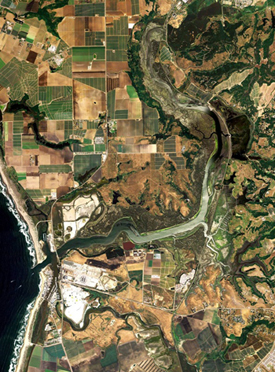 Photo: Elkhorn Slough National Estuarine Research Reserve
Photo: Elkhorn Slough National Estuarine Research Reserve |
An aerial view of Elkhorn Slough. The Old Salinas River channel runs parallel to the coastline from lower left, just behind the dunes, and empties into the harbor near the mouth of the slough. (Click on image to see larger photo.) |
|
|
California regulators have linked nutrients in the Salinas River directly to agricultural production. The Central Coast regional water quality control board is drafting new regulations requiring farmers to reduce nutrients in runoff. But negotiating these new rules requires a delicate compromise among growers, regulators, and environmental advocates.
Fueled by the excess nitrate, algae mats have spread throughout the slough over the past 20 years. If the nutrient levels in the water do not decrease, pea-green algae could cover the entire wetland, Haskins says.
Testing the waters
Estuarine ecologist Rikke Preisler is the newest participant in the slough’s monthly water quality monitoring program, which started in 1988. She visits ponds, agricultural ditches, and rivers around the slough each month, armed with plastic bottles and an automated sensor.
At her first stop on this February day, Preisler is at Strawberry Pond, a side channel near the middle of the slough. Pink bacteria, brown pond scum, and green algae like romaine lettuce float along the bank. “This is one of the grosser sites,” she says. “There are lots of algae and nutrients.”
It’s winter now, when rains bring nitrate-loaded runoff to the slough and nutrients collect in the mud. As the year progresses, this site will only look worse. Warm summer temperatures help algae flourish. John Haskins, water quality scientist at the slough and an avid surfer, wrinkles his face as he recalls wading into a summertime pond covered with thick algal mats. “It was gnarly,” he says.
The algae start a cascade of events that end with the death of worms and fish. “The algae act like a big giant aquarium pump, pumping in oxygen during the day,” Haskins says. At night, the algae suck up that oxygen to help them consume the sugars they made during the day.
Some of the slough’s ponds hyperventilate daily, alternating from over-oxygenated during the day and suffocating at night. Fish such as threespined sticklebacks and long-jawed mudsuckers, as well as a threatened species of snail, live in these ponds only because they can survive the dramatic daily changes. Sharks and rays may stop by on their tour of the slough, but the fluctuating oxygen levels deter them from staying.
Back at Strawberry Pond, Preisler places a silver plastic cylinder containing a cluster of computerized instruments in the shallow water. She’s measuring the water’s vital signs: temperature, pH, salinity, and oxygen levels. As the sensor rests on the sandy bottom, it accidentally kicks up a cloud of black silt. “Oh, look at that mud,” Preisler says with a sigh. The sediment clouds the detector and an extremely low oxygen reading appears on her handheld computer.
Without oxygen, few clams, worms, and snails live in this mud. And bacteria, unable to use oxygen to help them process nutrients, turn to other compounds—which cause them digestive troubles. They produce gas that smells like rotten eggs. During the summer, these ponds reek so badly that people living halfway up the hillside complain.
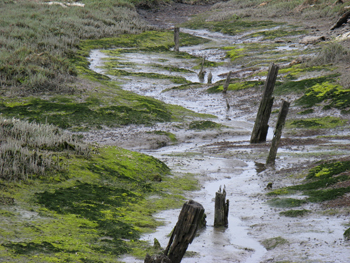
Photo: Melissae Fellet
|
Algae-covered mudflats at low tide in Elkhorn Slough. (Click on image to see larger photo.) |
|
|
Preisler’s next stop is Hudson’s Landing, near the headwaters of the slough. She samples the water on either side of a tide gate, a culvert covered by a metal flap. Water flows out from behind the gate, but the flap keeps saltwater from entering on the rising tide.
Dikes, tide gates, and railroad trestles isolate two-thirds of the estuary from the pull of the daily tides. Although nitrate levels are high throughout the slough, the yuckiest areas are behind these gates, where nutrients concentrate and algae mats grow unchecked. Brent Hughes, a graduate student at UC Santa Cruz, concluded that opening the tide gates, even slightly, would improve water quality. But it could increase another major threat to the slough: erosion [see sidebar: Saving the Slough with Steel]. “It’s a teeter-totter,” Hughes says. “If you manage for one [problem], then it makes the other one worse.”
Although the slough’s side ponds are scummy, its main channel is fairly pristine, thanks to the unintended consequences of a drastic construction project. In 1946, the U.S. Army Corps of Engineers rerouted the mouth of the slough to build a harbor. They punched through sand dunes south of the natural opening and straightened out the entrance to the main waterway.
Environmentalists have long criticized this controversial government agency for modifying waterways despite negative environmental effects. Indeed, this project increased erosion in the slough, but the large daily tidal exchange into and out of Monterey Bay keeps the algae and nutrient levels under control. Hughes calculates that the ebb tide sweeps about 9 million pounds of algae—the weight of 800 African elephants—out to sea each year. But that’s only half of the slough’s yearly production.
This difference in water quality is clear when Rikke Preisler stops at a sampling site near the slough’s mouth. It’s the only clean spot she’s visited all day. The water is clear and a bit choppy from a light breeze. An otter chomps on a silvery fish, while a seagull lurks nearby for a chance to poach its meal. “This is a really nice place,” she says.
Nitrate comings and goings
The slough’s monthly sampling program has revealed a steady increase in nitrate throughout the winter, but it took a system of automated sensors to figure out where the nutrients entered the slough. Visitors who know where to look can spot the yellow buoys and antennae, like the headpieces of Dr. Seuss characters. They mark the location of instruments that send hourly measurements of nutrients, salinity, and dissolved oxygen to Ken Johnson’s office at the Monterey Bay Aquarium Research Institute (MBARI), based near the slough’s outlet.
Johnson, an oceanographer, wants data—lots of it. “We tend to manage the environment, I think, often with no data,” he says. Measuring nutrient concentrations helps scientists track how microbes process the excess nitrate, and the sensors have made a huge difference. The slough “turns out to not work at all the way we thought,” Johnson says.
In 2000, Johnson needed a place to test and debug the wireless nutrient sensors that his group invented. So he moored them near his office, placing three sensors in the main channel of the slough and one in the old Salinas River channel.
 On a rainy day, Johnson watched a burst of nitrate surge past the sensor in the river channel. The swell then triggered the sensors in the slough as it rode the rising tide. He estimates that more than six tons of fertilizer enters the slough each day in this way. “It’s like a bit more than one great big dump truck sitting on Potrero Road over the tide gates, dumping out its load of fertilizer each day into the harbor and then into the slough,” Johnson says. On a rainy day, Johnson watched a burst of nitrate surge past the sensor in the river channel. The swell then triggered the sensors in the slough as it rode the rising tide. He estimates that more than six tons of fertilizer enters the slough each day in this way. “It’s like a bit more than one great big dump truck sitting on Potrero Road over the tide gates, dumping out its load of fertilizer each day into the harbor and then into the slough,” Johnson says.
Healthy estuaries naturally absorb nitrate. Bacteria convert it to nitrogen gas, which then evaporates into the atmosphere, or plants use it for food. But nitrate has overwhelmed Elkhorn Slough; it’s not one of the healthy ones. Johnson added a new sensor last year—one for ammonium—and found another unpleasant surprise. About 70 percent of the nitrate that enters the slough leaves as ammonium, a bacterial byproduct foreign to estuaries and oceans and toxic to fish.
Johnson thinks it’s possible to reduce the flow of nutrients into the slough. He even attended “Nitrogen School” with growers to learn how they apply fertilizer. But the challenge, as he’s learned, is steep.
Feeding farm fields
Fertilizing crops comes down to one thing: feeding the plant just enough nutrients to maximize its yield over the growing season, without leaving extra in the soil.
Farmers can draw from various resources to guide their fertilizer applications, such as recommendations from the University of California Cooperative Extension. But the guidelines aren’t always followed, says Michael Cahn, irrigation and water resources advisor at the extension office in Monterey County. According to the agency’s surveys, “Many [farmers] are on the mark and others are way beyond” appropriate fertilizer use, Cahn says.
Crops like baby lettuce and baby spinach require a burst of nitrogen fertilizer because they’re in the ground for only a month. Strawberries grow for a year, so farmers have more time to get nutrients into soil. “Our surveys show that growers, for the most part, do not over-fertilize strawberries,” Cahn says.

Illustration:
Andrea Lofthouse-Quesada
Keeping fertilizer on the fields calls for irrigation management. Runoff from fields watered with sprinklers can carry nutrients off fields, requiring more fertilizer applications for healthy plants. If this runoff isn’t properly collected, it can drain into rivers and seep into the ground. Drip irrigation directs water to the plant’s roots, preventing excess nutrients from escaping in runoff. Cahn says many farmers have switched from sprinklers to drip irrigation. But baby leafy greens are planted close together, making drip irrigation impractical.
“We’re learning what it takes to do things right,” says Bob Martin, general manager at Rio Farms, a Salinas Valley vegetable grower. “But it’s not always easy. We’re making daily decisions on the spot.”
Cahn recommends that farmers in the Salinas Valley tap into two bonus sources of nitrate to reduce each season’s fertilizer application. There are nutrients in the soil left over from previous crops. And there’s a hidden source for some fields: groundwater loaded with nitrates from years of past irrigation.
Martin contends that farming itself is the only way to clean up the groundwater. With careful drip irrigation, farmers can feed the plant with nitrate-loaded water and return cleaner water to the aquifer. “Shame on us if we don’t use that in our nutrient budgets,” he says.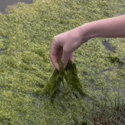
Most growers voluntarily take action to control runoff from their fields, says Daniel Mountjoy, soil conservationist at the California Natural Resource Conservation Service office in Salinas. They consult with local experts at the cooperative extension and resource conservation district to help them develop water-quality management plans that account for the soil type and slope of each field. These plans call for actions such as building ditches, wetlands, and buffer strips.
Even with these measures, MBARI’s sensors show that nitrate levels have increased at the old Salinas River monitoring site since 2004. Regulators at the regional water quality control board have noticed this increase. They’re now drafting an order requiring farmers to reduce nutrients in their runoff by a whopping 80 percent over five years. But the final mandate could be delayed by politics, legal battles, and contradictory scientific studies.
To help meet those goals, oceanographer Ken Johnson wants farmers to bury wireless nutrient sensors, like those in the slough, on their fields. Then farmers can check groundwater nitrate levels each morning and immediately determine the minimum amount of fertilizer to apply that day.
But these sensors aren’t mass-produced yet; one detector costs $15,000. That’s too steep for Salinas Valley growers. “Four sensors or a pickup truck and a tractor—which one are you going to buy?” Johnson asks. He wants to find a way to decrease this cost so farmers will adopt the technology quickly. Grower Martin welcomes his efforts. “We could always use better diagnostic equipment and more science,” he says.
If nutrient levels can be reduced, a conservation experiment has shown that the slough probably would recover. In 1997, the Elkhorn Slough Foundation purchased fields near ponds in the upper end of the slough. For some plots, strawberry fields extended to the water line, becoming submerged at high tide. Workers replaced the berry plants with natural vegetation near the water and crops needing little fertilizer on the hillside. Nutrient levels in that portion of the slough dropped by half within 10 years after restoration.
If farmers, scientists and conservationists can find a compromise before nutrient levels spiral out of control, the slough will remain a hidden jewel along Central Coast—a place where binocular-toting retirees watch birds on misty mornings, and rubber-boot-wearing students explore the squishy critters living in the mud. If not, more of the slough's channels may turn into gardens of green algae.
Sidebar: Saving the Slough with Steel

Illustration: Layla Lang
Steel gutters strung between beams driven 90 feet into the ground interlock to form an underwater wall. Boulders brace the wall and create a ramp to help fish and rays find their way up and over it.
This blockade serves as a tidal speedbump in Elkhorn Slough, slowing the outgoing tide and trapping mud behind it. “As sediment deposits on the salt marsh, it adds strength to the marsh, almost like a fresh coat of paint,” says Bryan Largay, director of the Tidal Wetland Project, an effort to reduce marsh erosion.
Humans drained portions of Elkhorn Slough for agriculture more than a century ago, and the ground shrank like a dried sponge. After the harbor was built at the mouth, water flowed through the slough faster than ever before. Now, the tides sweep mud out to sea each day, eroding the remaining marsh and removing habitat where clams burrow.
In 2004, scientists, land owners, and regulatory agencies considered several options to save the mud and the marsh. Some plans were drastic, including rerouting the mouth of the slough or building an underwater wall, or sill, at the mouth of the estuary. They finally decided to build this smaller sill across the entrance to Parson’s Slough, a branch of the main channel.
During construction, two people watched nearby seals and otters, recording their behavior every hour. Not much is known about how seals and otters react to sound. To learn more, the monitors will correlate the animals’ reactions to the level of noise generated during pile driving.
Scientists at the slough agree that building this sill is better than doing nothing, but some wish the erosion problem could be solved with a more natural approach. “It was the best solution with the hard challenges that we had,” says John Haskins, the slough's water quality scientist. “If we don’t do anything, it’ll get worse.”
In mid-January 2011, before all the rocks were placed around the wall, currents in the slough decreased for the first time in 60 years. Construction ended in May 2011. But determining whether the sill successfully reduces marsh erosion will take time—if it can be done at all. Says Haskins: “There’s so much variability in the system itself that trying to detect these tiny little changes. . . is going to be really hard.”
Story © 2011 by Melissae Fellet. For reproduction requests, contact the Science Communication Program office.
Top
Biographies
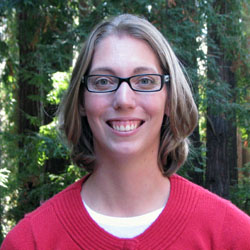 Melissae Fellet Melissae Fellet
B.S. (microbiology and biochemistry) University of Florida
Ph.D. (chemistry) Washington University in St. Louis
Internship: New Scientist (San Francisco)
I learned about science stories in an advanced organic chemistry class. In each lecture, the professor told a tale of an experimental adventure through uncharted territory. He always ended with a cliffhanger, leaving me eager for the next day’s discussion.
Seeking my own adventure, I worked in a chemistry lab using an electric circuit to see proteins recognize their targets. I soon realized the journey through the unknown was not what had intrigued me in class. What I truly appreciated were the human elements of the narrative—excitement, wonder, determination, and discovery. Science brought me to writing, and writing brings me to new science. With each story I write, I fall in love with both the science and the experience of being a scientist all over again.
. . . . . . . . . . . . . . . . . . . . . . . . . . . . . . . . . . . . . . . . . . . . . . . . . . .
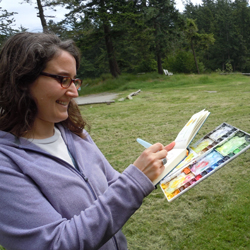 Andrea Lofthouse-Quesada Andrea Lofthouse-Quesada
B.A. (integrative biology) University of California, Berkeley
M.A. (education) Whittier College
Internships: Los Angeles County Museum of Natural History; Huntington Library and Botanic Gardens
Andrea Lofthouse-Quesada is a science illustrator and teacher based in Pasadena, California. She loves to draw plants, wildlife, rocks, and the human body. Her lifelong love of drawing from life and sketchbooks started as a teenager. Before starting her career as a science illustrator, Andrea taught science classes in Los Angeles public schools and worked in community gardens. Check out her website.
. . . . . . . . . . . . . . . . . . . . . . . . . . . . . . . . . . . . . . . . . . . . . . . . . . .
 Layla Lang Layla Lang
M.Sc. (biology) Swiss Federal Institute of Technology, Zurich
Internship: City of Hope, Division of Gene Regulation and Drug Discovery, Los Angeles
Layla is interested in visualizing complex scientific processes and topics and taking the viewer to the world of molecules and viruses, where illustrations can have a big impact on imagination and foster understanding. She has an extensive scientific background with specialization in molecular and microbiology. With her new training from CSU Monterey Bay, Layla will not only strive to bring visual clarity to complex subjects, but also hopes that her passion as an artist will be apparent in her work and will convey the beauty of nature.
Top |

